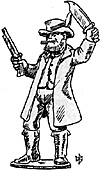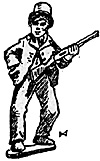Character and Action Cards
 As per standard rules, adding the following:
As per standard rules, adding the following:
- 1 card per zombie group (identifying that particular group).
1 card marked 'extra zombie action'.
1 card marked 'And the dead shall rise.'
Zombie Groups.
Zombies are formed in groups of 3 - 6 figures. Each group should be identifiable and distinguishable from the other groups (e.g. same figures or stance, same base colours or shape).
Zombie Actions.
When a zombie group card is drawn they may perform one of the following actions:
- Move.
Attack.
Move and attack.
Recover / Get up.
'Extra Zombie Action' Card.
When this card is drawn, place it on one side, the next zombie group to turn up its character card, may perform two actions.
'And the dead shall rise' Action Card
When this card is drawn, place it on one side, the next zombie group to turn up its character card, has all its destroyed zombies returned to the table. Returned zombies are placed at a given location (table edge, outside a particular building, in the graveyard etc.) decided upon at the start of the game or as dictated by scenario.
Zombie Movement.
Roll 1D6 : The score is the number of inches the group can move. If a six is rolled - each individual zombie in the group moves six inches then each rolls a D6 and moves that number of additional inches. If another 6 is rolled, the zombie falls over without making the additional move. Zombies move towards the nearest living creature (human, horse, mule).
Human Movement.
As per standard rules - in addition, an unconscious character can be carried or dragged by another if they are in base contact. Movement distances are halved when carrying or dragging.
Melee.
The melee system is the same as in the standard rules but with different values and results. Close combat against a zombie is like fighting a wild animal, they are also harder to destroy than living creatures: if a weapon cannot cause a severe head injury then it will be of little use against an undead opponent (except perhaps to push them away). Human melee weapons are classed in two groups:
- 1 'Effective Weapons' e.g. cavalry sabres, tomahawks, heavy clubs.
2 'Limited Weapons' e.g. short bladed knives, fists, knuckle dusters.
Zombies have no weapons but are ferocious fighters.
Combat Values:
Zombie. Attack 4 Defend 4
Effective Weapons Attack 3 Defend 3
Limited Weapons Attack 2 Defend 2
Modifiers:
- Opponent on the ground. +3
Per wound (bite) -1
Attacked from the side. -2
Citizen -1
Attacked from behind. -2
Shootist +1
Attacking from behind. +2
Legend +2
Only zombies from the same group having drawn an action card and moved into contact or started in contact may attack. Each melee is resolved separately. An attacker in contact with two figures can only attack one of them. Two attackers in contact with one defender can both attack that figure.
The attacker rolls the number of dice equal to the modified attack value.
The defender rolls the number of dice equal to his modified defence value.
If the defender rolls more sixes than the attacker, then the attacker has been knocked over.
Every six rolled by the attacker more than the defender counts as a hit.
Effect of hits against humans by zombies.
For each hit roll D6
- 1 Defender pushed back 2"*
2,3 Defender knocked down.
4,5 Defender bitten and wounded.
6 Torn apart and devoured**
*Characters are pushed back after the effect of all other hits have been resolved. The attacker does not follow up - consider this a lucky escape!
**All zombies within three inches of victim and not closer to any other living creature are liable to 'feeding frenzy' (see below).
 Feeding Frenzy.
Feeding Frenzy.
Any victim being devoured will attract the attention of other zombies near by. Like jackals they will fight over the body. All zombies within three inches of victim and not closer to any other living creature are moved into contact to join the feeding frenzy and will need to recover before they can move away. Remove the red marker or victim when there are no more zombies in contact with it.
Effect of Bites.
Roll for wound effect and location as per standard rules. For every bite roll 1 D6 each action turn - a roll of six causes them to lapse into unconsciousness for the rest of the game.
Effect of hits against zombies from effective weapons.
For each hit roll D6
- 1,2 Pushed back 2"
3,4 Knocked down.
5,6 Destroyed.
Effect of hits against zombies from limited weapons.
For each hit roll D6
- 1,2,3,4 Pushed back 2"
5,6 Knocked down.
Zombies lying on the ground will be destroyed by a knocked down result.
Shooting.
As for standard rules. Zombies cannot shoot.
Effects of shooting (Only a bullet in the brain will destroy a zombie) Roll only one wound effect location dice:
- 6 Head shot - target destroyed.
5 Knocked over
1 - 4 No effect.
Point blank range add 2 to dice for pistol.
Short range add 1 to dice for rifle.
Shotguns.
The shotgun rules in RWNN are simplified as follows:
Treat shotguns as pistols for range and effect. Shoot twice.
Sawn-off shotguns may only fire up to close pistol range. Shoot three times.
Musketoons as per sawn-off shotguns but shoot four times.
Any figures within one inch of target also receives the equivalent of one pistol shot.
All above weapons must take a turn to reload after firing and cannot blaze away.
Group targets.
Legends and shootists can fire at more than one target if they are bunched together. A shootist can fire at any other targets within three inches of nominated zombie. A legend can fire at any zombies within four inches of the nominated target.
Zombie recovery.
On falling down or being knocked down, a zombie must roll a 4, 5 or 6 to get up. In a feeding frenzy, a zombie must roll a 4,5 or 6 to be able to move away from the marker.
Zombies do not 'duck back'.
Human recovery.
Humans knocked down need 1 turn to recover and one turn to get up. Unconscious or badly wounded characters will need to be carried.
Character Advancement.
Upon destroying a zombie, any 'citizen' immediately advances one level to become a 'gunman'.
Horses.
Horses are spooked within 5 inches of zombies - roll D6, a 5 or 6 causes the rider to be thrown from his mount.
Advanced Rules.
1. Zombie Plague.
In the basic rules, if a character receives a bite from a zombie, he runs the risk of falling unconscious. Matters are now worsened by the chance that the bite will infect the character, killing him and turning him into a zombie. Additional zombie figures will be required to represent these 'fallen characters' and will need to be sufficiently distinctive to allow them to be identified as individuals.
Replace original 'Effect of hits against humans' chart with the following:
Effect of hits against humans by zombies:
For each hit roll D6
- 1,2 Defender pushed back 2"
3 Defender knocked down.
4 Defender bitten and wounded.
5 Defender bitten and dies, succumbing to the zombie plague.
6 Torn apart and devoured
Replace original 'Effects of Bites' section with the following:
Effect of Bites.
Roll for wound effect and location as per standard rules.
For every bite roll 2 D6 each action turn - a roll of six causes them to lapse into unconsciousness. Once unconscious, roll one D6 each turn: A roll of 6 causes the character to recover without ill effect; a roll of one and the character dies, succumbing to the zombie plague.
Effects of Zombie Plague.
If a character succumbs to zombie plague they become a zombie: replace original figure with a zombie model. Keep a note of which zombie figure represents which character. Keep the original character card in the pack which will now act as a zombie group card (albeit a group of one). Single zombie characters, once destroyed, do not return when the 'And the dead shall rise' card is played.
2. Zombie Gunslingers.
The rules were originally written with George A. Romero style zombies in mind - unintelligent, badly co-ordinated flesh eaters. I did not consider them capable of using fire arms. However, Foundry Figures then produced a set of seven zombie gunslingers. I liked them so much, I had to include them in my rules.
Rationale. A zombie still retains a vestige of the drives and instincts from his original living personality. Zombies do not devour flesh for nourishment but as part of a corrupted memory of the human need to eat. A zombie who's human original was an experienced gunman will therefore retain a degree of his shooting skill. Any character above the level of citizen will become a zombie gunslinger if they succumb to the zombie plague.
Shooting.
Gunslingers are the only type of zombie that can shoot. They move and fight like other zombies except that if they roll a one for their movement, they shoot at the nearest human target instead of moving. If a one is rolled following a six the zombie shoots but counts as moving. If a zombie gunslinger is shot at and survives, it will immediately turn to face the shooter and return fire. Shooting is resolved as per standard rules. Zombies cannot aim or blaze away. All gunslingers are classed as 'gunmen' irrespective of their previous incarnation.
Too many zombie gunslingers will slow down and unbalance the game. To keep the numbers down, limit them to a maximum of one gunslinger per group or have none to begin with, relying on the zombie plague rules to provide a few gunslingers from the human casualties.
Back to Table of Contents -- Lone Warrior #126
Back to Lone Warrior List of Issues
Back to MagWeb Magazine List
© Copyright 1999 by Solo Wargamers Association.
This article appears in MagWeb (Magazine Web) on the Internet World Wide Web.
Other military history articles and gaming articles are available at http://www.magweb.com
